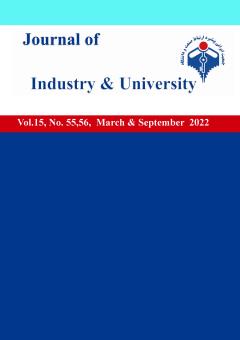Using Fuzzy Values in the Whale Method to Solve the Problem of Locating Terminal Locations
Subject Areas : Special
Mehdi Fazli
1
![]() ,
haasan hoseinzadeh
2
,
haasan hoseinzadeh
2
1 - Assistant Professor, Department of Mathematics, Ardabil Branch, Islamic Azad University, Ardabil, Iran
2 - Associate Professor, Department of Mathematics, Ardabil Branch, Islamic Azad University, Ardabil, Iran
Keywords: Whale Algorithm, Location Problem, Fuzzy Values, meta-heuristic,
Abstract :
In this article, fuzzy values are used in the meta-heuristic method to locate the location of the terminal facility. This article is written based on a modern method inspired by nature called Whale Algorithm and it is tested on scientific optimization problems and modeling problems. To evaluate the performance of the proposed method, fuzzy coefficients have been applied to solve the location allocation problem, in such a way that the hypotheses of the problem, fuzzy random variables and the capacity of each center are considered unlimited. According to the results of this research, the problem of locating the terminal locations is practically solved and the optimal location of these facilities is proposed in the real world. Also, the numerical optimization results show that the proposed method has a better performance than similar methods
1. SALHI, S. , RAND, G. K. 1989. The effect of ignoring routes when locating depots. European journal of operational research, 39, 150-156.
2. OR, I. , PIERSKALLA, W. P. 1979. A transportation location-allocation model for regional blood banking. AIIE transactions, 11, 86-95.
3. JACOBSEN, S. K. , MADSEN, O. B. 1980. A comparative study of heuristics for a two-level routing-location problem. European Journal of Operational Research, 5, 378-387.
4. WASNER, M. , ZÄPFEL, G. 2004. An integrated multi-depot hub-location vehicle routing model for network planning of parcel service. International Journal of Production Economics, 90, 403-419.
5. PERL, J. , DASKIN, M. S. 1985. A warehouse location-routing problem. Transportation Research Part B: Methodological, 19, 381-396.
6. Holland JH . Genetic algorithms. Sci Am 1992;267:66–72 .
7. Rechenberg I . Evolutionsstrategien. Springer Berlin Heidelberg; 1978. p. 83–114 .
8. Dasgupta D, Zbigniew M, editors. Evolutionary algorithms in engineering ap- plications. Springer Science & Business Media; 2013 .
9. J.R. Koza, “Genetic programming,”1992.
10. Simon D . Biogeography-based optimization. IEEE Trans Evol Comput 2008;12:702–13 .
11. Erol OK , Eksin I . A new optimization method: big bang–big crunch. Adv Eng Softw 2006;37:106–11 .
12. Rashedi E , Nezamabadi-Pour H , Saryazdi S . GSA: a gravitational search algo- rithm. Inf Sci 2009;179:2232–48 .
13. Kaveh A , Talatahari S . A novel heuristic optimization method: charged system search. Acta Mech 2010;213:267–89 .
14. Formato RA . Central force optimization: A new metaheuristic with applica- tions in applied electromagnetics. Prog Electromag Res 2007;77:425–91 .
15. Kennedy J , Eberhart R . Particle swarm optimization. In: Proceedings of the 1995 IEEE international conference on neural networks; 1995. p. 1942–8 .
16. Dorigo M , Birattari M , Stutzle T . Ant colony optimization. IEEE Comput Intell 2006;1:28–39 .
17. Goldbogen, J.A., et al., Integrative approaches to the study of baleen whale diving behavior, feeding performance, and foraging ecology. BioScience, 2013. 63(2): p. 90-100.
18. Mirjalili, S., & Lewis, A.(2016). The Whale Optimization Algorithm. Advances in Engineering Software Volume95, Pages 51-97
19. R.E. Bellman, L.A. Zadeh, Decision making in fuzzy environment, Mang. Sci. 17(1970) 141–164.
20. L.C. Bezdek, Fuzzy models- What are they and why? IEEE Trans. Fuzzy Syst. 1(1) (1993) 1–9.
21. D. Dubois, H. Prade, Fuzzy Sets and Systems, Theory and Applications,Academic Press, New York, 1980.
22. H.J. Zimmermann, Fuzzy Set Theory and its Applications, 3rd ed., KluwerAcademic, Norwell, 1996.
23. C. Garcia, J.L. Verdegay, On the sensitivity of membership functions for fuzzylinear programming problems, Fuzzy Sets Syst. 56 (1993) 47–49.
24. N. Mahdavi-Amiri, S.H. Nasseri, Duality results and a dual simplex method forlinear programming problems with trapezoidal fuzzy variables, Fuzzy SetsSyst. 158 (2007) 1961–1978.
25. R.R. Yager, A procedure for ordering fuzzy subsets of the unit interval, Inform.Sci. 24 (1981) 143–161.
26. Rath, S. and W.J. Gutjahr, A math-heuristic for the warehouse location–routing problem in disaster relief. Computers & Operations Research, 2014. 42: p. 25-39.
27. B.P. Mirchandani, R.L. Francis (Eds.), Discrete Location Theory,Wiley-InterScience, New York, 1990.
28. R. Ghanbari, N. Mahdavi-Amiri, Solving bus terminal location problems usingevolutionary, Appl. Soft Comput. 11 (2011) 991–999.
29. R. Ghanbari, S. Babaie-Kafaki, N. Mahdavi-Amiri, An efficient hybridization of genetic algorithm and variable neighborhood search for fuzzy bus terminal location problems with fuzzy setup cost, in: Proceedings of the Second Joint Congress on Fuzzy and Intelligent Systems, Malek-Ashtar University, Tehran, Iran, October 28-30, 2008, pp. 134–140.
30. D. Ghosh, Neighborhood search heuristics for the uncapacitated facilitylocation problem, Eur. J. Oper. Res. 150 (2003) 150–162.


